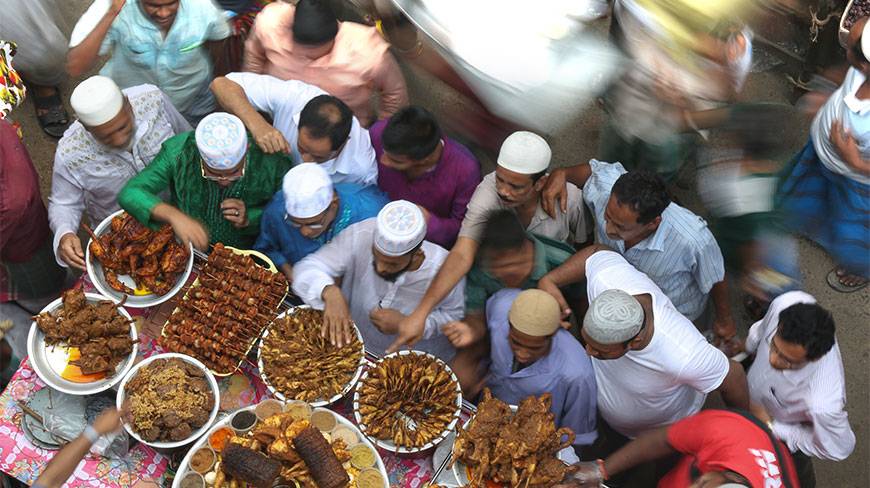Ramadan is about abstinence though there’s no stopping most of us from undertaking gastronomic adventures. Admit it: No point in making the month a drab affair. So, if someone wants to wake up late in the night and think: “Ok, I have had enough of sehri at home, today I will head for the Old part of town,” no one can blame that person.
Of course, before one heads towards the old city, an understanding of reality is a must. For those who are besotted by the Old Dhaka food fantasy, it’s better to come down to earth and accept things as they actually are.
First, with the monsoon lashing the city, it’s good to remember that to go to Chawkbazar, or Chawk as its known in short, to buy iftar, one has to be prepared for mud-world. A bit like water-world, there’s mud on the ground and the food is placed on tables that are placed on the dirty ground. The sellers are least bothered about the condition below.
So, do you have the mental tolerance to juxtapose mud and mutton roast, and dismiss the former with the thought: “Who cares about the dirt and water? It’s at least four feet from the table.”
Despite the messy setting and the pandemonium, I go there every year – you know that the scene will repel you, yet it’s difficult to resist. You are possibly thinking: “The food is so great that all other inconveniences can be forgotten.” Nope, the food, sorry to puncture your fantasy, is just average – at times even below that.
The mystique of Old Dhaka iftar rests in the fact that the food sold there have a savage attraction to it. Where else will you find someone luring you with a roasted leg of lamb? Or stacks of roasted pigeons placed on a large tray garnished by at least 50 boiled eggs. There’s something elemental here which strikes a chord with the hedonistic feasts of Rome at the height of its decadence.
It appeals to the wild side latent in all of us. “Two leg of lambs, four roasted birds, and three large chunks of kebab,” keep your eyes closed and utter this line a few times and you will start to feel a primordial pleasure running down the senses. Coarse but pleasurable.
Then of course there is the much-hyped dish named Boro Baaper Polae Khae, which means “eaten by sons of wealthy men.” Why would you give such a peculiar name to a dish? Simple – to attract attention. A mixture of shredded chicken, chickpeas, lentils, eggs, chilies, and God knows how many other stuff, this is the most obnoxious thing I ever tasted.
The seller tells me with an imperious tone – once sons of rich people came in large cars to take this dish back home. Yeah, what did the rich man’s son have at home – Frankenstein? No, I didn’t ask him that.
Long time ago, when this dish had not made a place within urban myth, I bought some for my father-in-law who, a Dhakaiya himself, after tasting a little, said with a contorted face: I am renaming it Fakinnir Polae Khae (eaten by sons of vagrants).
Here’s one suggestion: Bring some of this dish and then use it as rodent bait. Trust me, rats will flee … who needs the Pied Piper of Hamelin when you have Boro Baaper Poale Khae?
But surprisingly, Boro Baaper Polae Khae is sold in tonnes every day because the marketing is done in such a way that buyers forget the miserable taste. After all, one year is a long time and people forget fast.
Old Dhaka was once famous for Shutli Kebab (thread Kebab) – meat tied by threads and then made into kebab. Back in the 70s, it had meat in it so one could safely call it beef Shutli Kebab. Now, the ratio of beef has gone down so it’s 75% lentils and 25% beef. Lentil Shutli Kebab! Need I elaborate on the taste?
A few years back, the sight of a whole roasted chicken was too much to resist and we bought a few, deciding to take all the food to the Dhaka University field for an iftar on the greens. Have been doing this for more than a decade.
Anyway, on our way, the adhan rang out and we stopped the rickshaw in front of an unusually large wall. The chicken – due to exposure to the heat – had a funny smell, and the large wall turned out to be the demarcating boundary of the Dhaka Central Jail. Gobbling down stale meat by the jail gate seemed surreal. I was thinking of Papillon!
The bottom line is – despite the flamboyance surrounding Old Dhaka iftar, the food is just basic. What is attractive is the visceral energy that accompanies the selling of the items. Large rods with skewered birds are not something one sees every day.
Yet, we go there every year, forgetting the promise made the year before of never venturing to the old part of town. We go not because of the food but because of the undying effervescence of the old city. There is life in every act. There is vivacity.
The biriyani or the tehari may not be of top quality, but the joie de vivre that comes with each packet is still unspoilt. Yep, looks like I have to go there this Thursday once more.
Meanwhile, if you are interested to have some stale chicken, cheese fritters without any cheese inside, tikia kebab which is mainly lentils, then please come and join me at the Dhaka University gymnasium field. At least, the leg of lamb won’t be that bad so, as the sun sets, you can tear off meat from the leg and relive Neanderthal culture. Me Tarzan … where Jane?
Source: Dhaka Tribune










